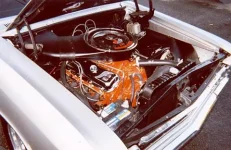Some of you guys might have noticed I like to partake with the topic of engine shutdown heatsoak. I tend to have what EricTheCarGuy describes as excessive mechanical sympathy. This project has been almost a year in the making, and I finally got the system working, after a lot of thinking, design, mock ups, searching and online shopping, and lots of Youtube video learning.
Before I start , I want to stress that I suck at electrics and electronics especially the electronics bits. But I do have soldering experience thanks to my RC Car hobby. I have to repeat to myself several times which wire goes to where, and had to search on forums and Youtube videos to get ideas and understand concepts.
The system consists of :
1. A remote control relay, 12V powered.
2. A Programmable temperature controller with wire probe, max detect temp 120C, also 12V powered.
3. Automotive 40A 4 pin relay.
4. Three 80mmx38mm Ball bearing brushless fans, load draw 1A.
5. Many lengths of 20ga and 16ga wires, in black, red and yellow.
6. Tiny Switches
7. Compact fuse holders
8. Tight fit connectors 2 different types
9. Small Diameter cable trunking.
10. Own designed fan brackets and 3D printed housings and air ducts.
First the system inside the car. I pulled a + and - from the radio adapter connector which is always live and fused to the radio. Soldered a XT30 connector. Plugged the Wires to another XT30 connector which supplies power to the system. The Heart of the system is the 12V remote control relay. The 12V power mentioned earlier goes to this relay. Before it reaches the Remote control relay, it goes through a 1A fuse and a tiny switch, so I can cut power to everything when I dont want the system to be misused (car at mechanic or in some one else hands). The remote control relay will send 12V power to the Temperature control relay when I want it to , namely by pressing button A on the remote. The reason I used a remote control is so that I can turn on/off the system without opening the doors.
The temp controller then has its own relay which activates when the temperature detected (in this case the rocker head surface ) is above the set temperature. This temp relay also has a tiny switch wired after the relay so that I can cut power to the fans and use the system merely to detect the head temp.
Both these electronic modules are housed in a 3D printed plastic housing which is taped on the right side below the steering wheel, and It allows me to see the temp controller target temp and actual measured temp, as well if the relays are turned on.
The temp probe and the 16ga + wire from the temp relay is routed into the engine bay. The + wire is attached to pin 86 on the 4 pin relay, and pin 85 will go to ground. The + from battery goes through a 3A fuse to pin 30, and pin 87 powers the 3 fans in parallel. The fans then take each ground from the best ground point nearby. The fans are attached on brackets I designed that mount on the best available space I have. One fan is under the turbo and is the lowest placed fan , so it sucks in relatively cool air from below and blows it up to the hood surface. One exhaust fan is placed on the opposite end near the fire wall which will suck out and eject hot air through the small gap between hood and fender, I designed my own vacuum cleaner type ducting made with 3D prints.
One more fan is mounted ahead of the power steering pump and blows underneath the front turbo towards the fire wall. I am not too happy with this fan position so I turned it last night to suck hot air out and eject it through the radiator. I have not tested this latest configuration . The last 20+ cycles I tested was in the previous configuration, but what I didnt like about it was it was forcing the hot air out towards the lower part of the windscreen , heating the localized area of the windscreen to nearly 60C.
Overall the system works well and is not a terrible drain on the battery, but I am still doing some fine tuning. The system achieves its intended goal of quicky lowering peak shut off temperature under the hood which otherwise stays hotter for way longer. Now I am able to bring down a 91C head surface temp down to 57C in 1hr 30 mins. I chose 57C as it is a temp that isnt damaging to the wires and rubber hoses, and if I go much lower I would be running the fans for too long and may drain the battery too much. Initially I set it to 45C but finally settled on 57C.
For now I give a sneak peek of the brain of the system ,I will post up the youtube video by tonight.
View attachment 74188
View attachment 74189

